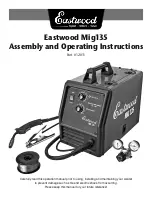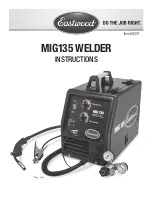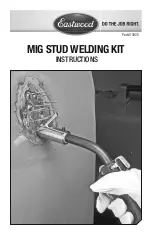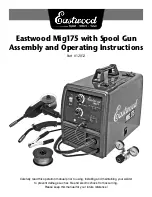
Weldmatic 356 & 396 | Operator Manual | Model No CP147-2, CP148-2
13
12
6 NORMAL WELDING SEQUENCE
Weld Start
Closing the welding gun switch initiates this
sequence of events:
– The gas valve is energised and gas flow
commences and continues for any pre-
gas time set
– The power source contactor function
is initiated. Welding voltage is applied
between the work piece and the
consumable wire
– The wire drive motor is energised
– The wire touches the work piece, and
the arc is established.
Weld End
Releasing the gun switch initiates this
sequence of events:
– The wire drive motor is de-energised,
and is dynamically braked to a stop
– After a short pre-set period, known as
the ‘burn-back’ time, the Power-source
contactor function is released. This
period ensures that the consumable
wire does not ‘freeze’ in the weld pool
– At the completion of any post-gas time
set, the gas valve is de-energised and
the flow of shielding gas ceases.
7 BASIC WELDING INFORMATION
Choice of Shielding Gas
The choice of shielding gas is largely
determined by the consumable wire to
be used. Many proprietary shielding gas
mixtures are available.
The recommended shielding gases for use
with the Weldmatic 356 & 396 are:
– Mild Steel:
Argon + 5 to 25%
Carbon Dioxide;
100% CO
2
– Aluminium: Argon;
– Stainless Steel: Argon + 1 to 2%
Oxygen.
Consult your gas supplier if more specific
information is required.
Shielding Gas Flow Rate
In G.M.A. welding, one function of the
shielding gas is to protect the molten weld
pool from the effects of oxygen in the
atmosphere. Without this protection the
weld deposit becomes ‘honeycombed’ in
appearance, an effect which is described
as weld porosity.
In draft-free conditions the gas flow rate
required to give adequate protection is
typically 10-12 litres/min. In situations
where drafts cannot be avoided, it may
be necessary to increase this rate up to
20 litres/min, and/or to provide screening
of the work area.
Weld porosity can also be caused by
air entering the gas stream through a
damaged hose, loose gas connection, or
from restriction in the nozzle, such as from
excess build-up of spatter.
When welding aluminium, particular care
must be taken with all aspects of shielding
gas delivery and workpiece preparation in
order to avoid weld porosity.













































